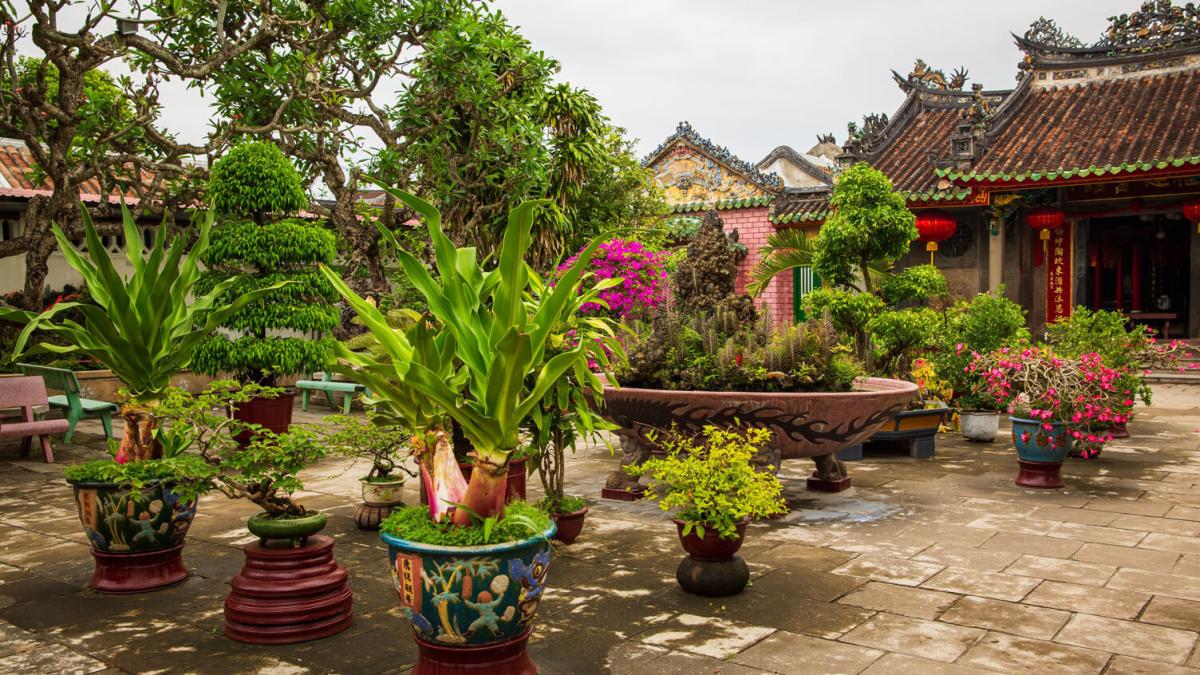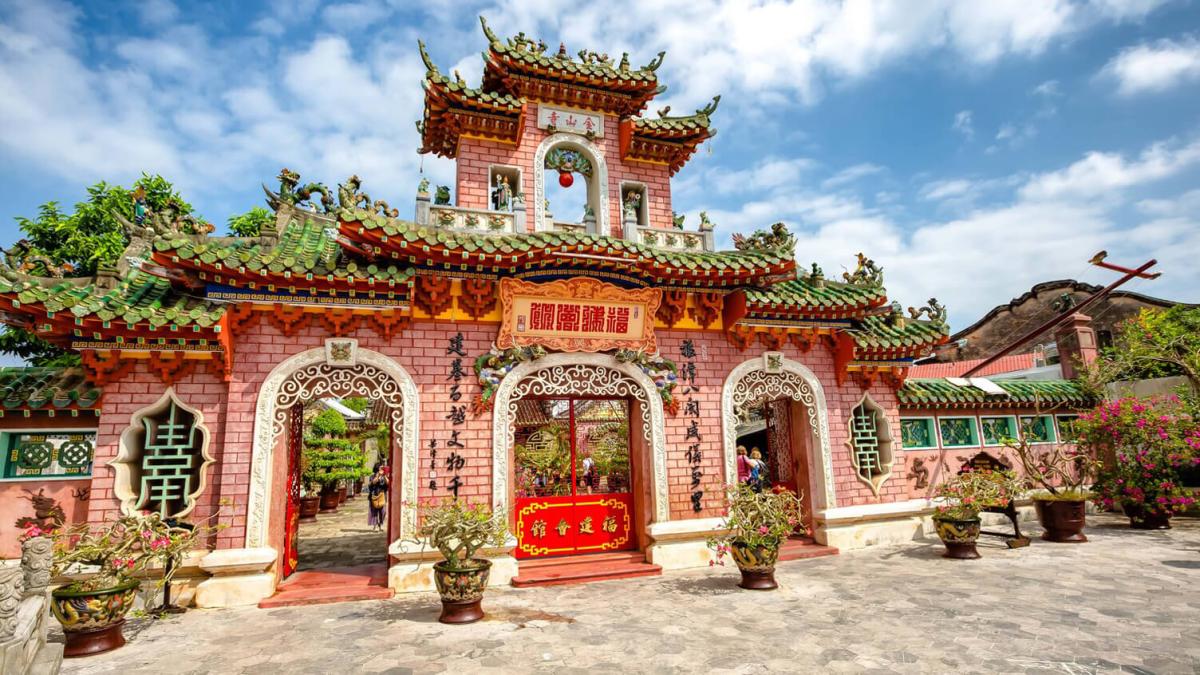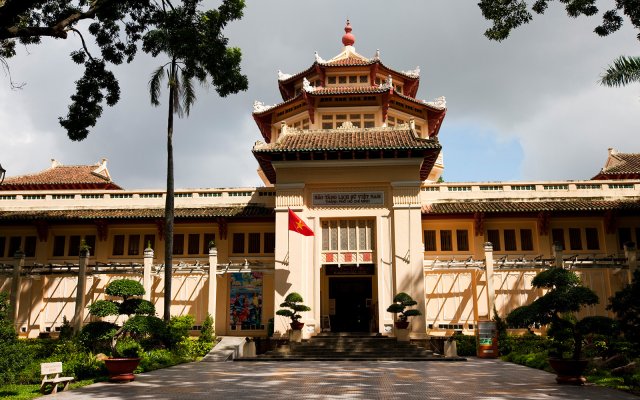The Fujian Assembly Hall is undoubtedly a must-see destination in Hoi An. Its unique and impressive architectural style exudes a serene and spiritual atmosphere that is sure to captivate any visitor. If you have plans to visit Hoi An soon, make sure to add the Fujian Assembly Hall in Vietnam to your itinerary.
Where is Fujian Assembly Hall
Constructed by Chinese merchants who moved to Hoi An, Fujian Assembly Hall covers an astonishing 2000 square meters of land in the heart of the old town. Tourists can easily explore the architecture and other nearby areas, making it an ideal site for sightseers.

Fujian Assembly Hall Location: No 46, Tran Phu Street, Hoi An Old Town, Quang Nam Province, Vietnam
Opening hours: 07:00 – 17:00 daily
Ticket price: Free entry to Fujian Assembly Hall (Please note that Hoi An Ancient Town’s entrance fee is 150.000 VND/ person for international tourists which includes 5 visiting sites)
The History of Fujian Assembly Hall
The Fujian Assembly Hall, constructed in the 16th century, is a significant historical landmark and an outstanding example of cultural and architectural prowess in Hoi An City. Its impressive and splendid design, adorned with striking red hues and intricate patterns, is a standout feature that enriches the already stunning ancient architecture of the old town.

Legend has it that Fujian Assembly Hall’s predecessor was a small temple that worshiped a statue of Thien Hau (Heavenly Holy Mother) salvaged at the Hoi An seaport in 1697. Thien Hau, also known as Mazu or Tian Hou, is a Chinese sea goddess who grants safe ocean travel to fishermen and sailors. The Assembly Hall eventually evolved into a gathering place for the earliest Chinese settlers in Hoi An.

Thanks to the unwavering support and generous contributions of overseas Chinese, the Fujian Assembly Hall has undergone numerous renovations and repairs, each adding to its already impressive grandeur. Today, this magnificent landmark stands as a testament to the skillful hands and artistic vision of the ancient people, which plays an integral role in the embellishment of Hoi An’s historical architecture. Any visitor to the Assembly Hall is guaranteed to be in awe of this breathtaking work of art.
What to See in Fujian Assembly Hall
Among the Chinese structures in the town of Hoi An, the Fujian Assembly Hall design stands out with its spacious and beautiful interior. Originally constructed with wood, this building was later renovated with bricks and tiled roofs, adding to its durability and aesthetic appeal. Visitors come to the Assembly Hall to marvel at the exquisite and skillfully crafted architectural works.
Three-arched Gate (Cổng Tam Quan)
The Three-Arched Gate is an impressive structure composed entirely of porcelain and topped with a gracefully curved tiled roof. The gate’s three entrances are designed in the traditional “male on the left, female on the right” style and carry symbolic meanings of “heaven, earth, and human.” According to ancient beliefs, the middle door is typically kept closed to prevent negative energy from entering and is only opened for significant occasions such as festivals, funerals, or weddings.

Upon entering the Assembly Hall through the Three-Arched Gate, visitors are greeted with a spacious garden featuring a stunning dragon fountain and a row of lush green trees. To fully appreciate the scenery, visitors should take a leisurely stroll in the following order: Three-Arched Gate, Inner Courtyard, Fountain, Ornamental Trees, East and West Halls, Main Hall, Back Courtyard, and Rear Hall.
Main Hall (Chánh Điện)
Inside the Main Hall, one can find shrines dedicated to the Holy Heavenly Mother, the Lady Buddha, the God of Wealth, the 12 Midwives, and the 3 Holy Mothers of Childbirth. These statues of holy figures are displayed with utmost solemnity alongside other priceless artifacts of great cultural significance.

Rear Hall (Hậu Tẩm)
At the Rear Hall, both locals and foreign visitors light large incense coils to pray for the well-being and prosperity of their loved ones. These incense coils are notable for their ability to burn continuously for over 30 days, with organizers at the Assembly Hall ensuring their flames remain lit.

Besides, the Hoi An Fujian Assembly Hall is home to an impressive display of statues for worship, bronze bells and drums, incense burners, intricate horizontal lacquered boards, and a host of other valuable artifacts.
Traditional Festivals
The Assembly Hall of Fujian Chinese Hoi An is widely recognized as a sacred place with the power to grant wishes, attracting local residents and visitors alike in search of blessings. As a result, the Fujian Assembly Hall is particularly crowded on new and full moon days, as well as during Tet holidays, with numerous engaging festival activities. Noteworthy festivals include the Lantern Festival (January 15th on the lunar calendar), the Luc Tanh ceremony for six esteemed Fujian generals (February 16th on the lunar calendar), and the ceremony of Thien Hau Holy Mother (March 23rd on the lunar calendar), among others.

On the second day of the second lunar month, the Chinese community in Hoi An celebrates their most special ceremony. They prepare a variety of ritual offerings for the God of Wealth, including paper money, gold, silver, wine, and three types of boiled foods: eggs, crabs, and pork. It is a day filled with tradition and reverence for the locals, providing a truly unique experience to visitors.
Visiting Tips
The Fujian Assembly Hall Hoi An is a place of worship, so visitors are expected to follow certain etiquette rules when visiting:
- Dress appropriately when entering the shrine;
- Keep your voice down within the shrine to pay respect to the deities;
- Avoid smoking or stepping on animal statues;
- Keep an eye on your belongings during crowded ceremonies;
- Large incense sticks and offerings are available inside the temple, so there’s no need to bring your own items from outside;
- If you don’t want to walk a lot, you can rent a bike or a cyclo to get to the Three-arched Gate and then walk to the temple for sightseeing.
Hopefully, with the information provided by Asia Legend Travel above, you will learn more about the Fujian Assembly Hall, a famous landmark in Hoi An Ancient Town. This hall has not only witnessed a significant period in Vietnam’s history, but its architectural design, featuring intricate wood carvings and beautiful sculptures, also contributes to Vietnam’s architectural legacy.
Tours related to Hoi An
$1,307+
$871+






Related travel guides
Da Nang to Hoi An: Essential Travel Tips and Options
Cost of Living in Vietnam: Average Expenses for Travelers
Places in Southeast Asia: A Journey to Paradise on Earth
Hoi An Journey: Top 10 Must-Visit Tourist Attractions